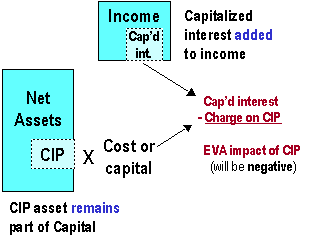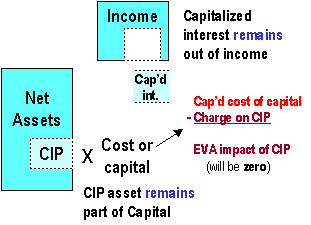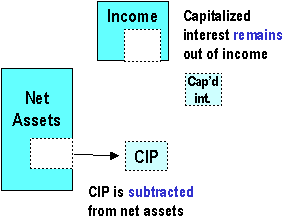Construction in Progress
Construction in progress (CIP) is a PP&E account for self-constructed assets not yet placed in service and, therefore, not yet generating income.
When CIP is expected to extend for a significant period of time, it may accrue capitalized interest until the asset is placed into service. This interest is accrued at the companys pre-tax cost of borrowing and based on the amount of debt used to finance the asset.
Identifying CIP allows investors to be aware of investments in self-constructed assets. This enables them to separate such investments in calculating returns on productive assets to gauge the fundamental health of the business. Capitalized interest represents a "holding period cost" for assets not in service.
Economics of CIP
Assets values are based on their current and future ability to generate cash. For assets whose cash generating ability is in the future, the market will build those future cash flows into the firms present value
Decisions about marginal investment in CIP should weigh that investment's effect on projected marginal returns and the timing of returns. How those assets are financed is irrelevant to its valuation, except to the degree that this specific investment benefits from certain credits not commonly available to other investments in similar assets.
Behavioral Impact
Management may react perversely to incentives for self-constructed facilities depending on how CIP is treated under EP.
If CIP is considered part of capital (as it is in Baseline EP, management may eschew self-construction in favor of acquisition to avoid a capital charge on assets not yet generating revenue.
If CIP is not considered part of capital, management may be encouraged to unnecessarily extend CIP investments to extra accounting periods. In extreme cases, they might indulge in marginal investments with insufficient yields in order to achieve that time extension. For example, a warehouse nearing completion, but no longer expected to be well utilized, can be kept in CIP by adding space.
Depending on the treatment of CIP and how it is being tracked, unnecessary investment may be a costly but effective way to delay "the day of reckoning."
Capitalized interest has the effect of creating an artificial "cost of debt return" on a portion of the CIP asset while it is being accrued. In the unusual situation where this "return" is higher than the cash return of the asset once it is brought into use, this can further encourage delaying placement of the asset into service.
Thus, alternative treatments of CIP must balance matching the costs of CIP with it benefits while preserving accountability for assets under management's control.
Alternative Treatments
Charge for CIP Capital (default):
We can retain all net assets in Baseline EP by allowing CIP to be a component of Capital for which management is charged at the cost of capital. This focuses management on the investment in CIP assets from the time of the initial investment.
To the extent that interest is being capitalized, that would need to be added to income. Thus, EP losses due to the charge on CIP capital would be somewhat offset by capitalized interest.
This treatment leaves managers fully accountable for the asset, encouraging them to bring the asset into use as quickly and productively as possible. This incentive reduces the need for controls on placing assets into service.

The shortcoming of this approach is that it does a poor job of matching CIP costs with their benefits. Management will be bearing a charge on an asset not yet in productive service, which might encourage under-investment in self constructed assets relative to potentially less valuable options to purchase.
Capitalize CIP at the cost of capital:
We preserve some accountability by including CIP in the capital base where it is subject to a charge for capital, as before. However, we can achieve better matching for CIP assets by capitalizing CIP on the entire asset at the cost of capital, i.e., by an amount equal to the foregone capital charge. (This would be done instead of adding capitalizing interest back to income.)
This treatment creates EVA-neutral results during construction while preserving accountability for capital when the asset is placed into service.

However, this treatment does not eliminate managements incentive to delay the onset of poor investments. If anything, it increases the incentive toward delay whenever an EVA-neutral "credit" would be replaced by an EVA-deficient NOPAT. This treatment must therefore be coupled with strict controls on when an asset must be brought into service.
Remove CIP from the measure:
Management can eliminate CIP from capital and capitalized interest from income. This treatment essentially makes CIP assets look like acquired assets at the time they are brought into service and moved from CIP to a long-term PP&E account such as building, plant, or equipment.
At the time CIP is held out of EVA, it should be growing at least with capitalized interest. Management would be encouraged to delay placement of these assets only if their expected post-placement returns were less than capitalized interest, which is a lower threshold than the cost of capital. This preserves a reasonable amount of matching and accountability.

However, because judgement remains about the placement of CIP assets into service, this treatment requires some central control.